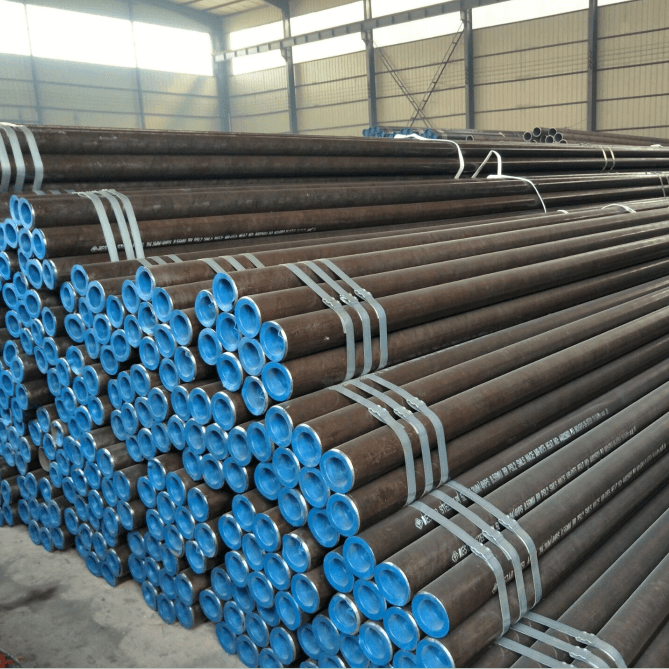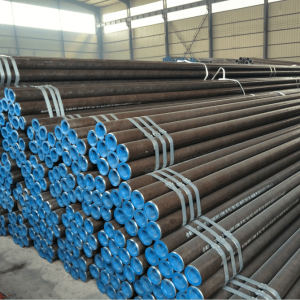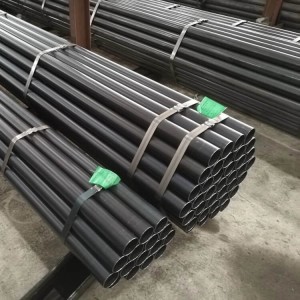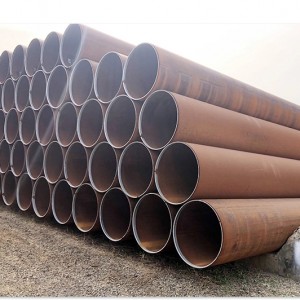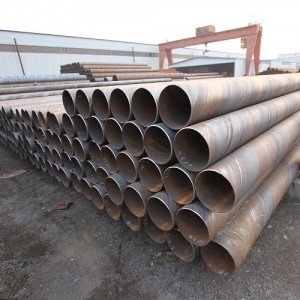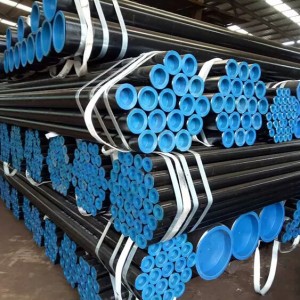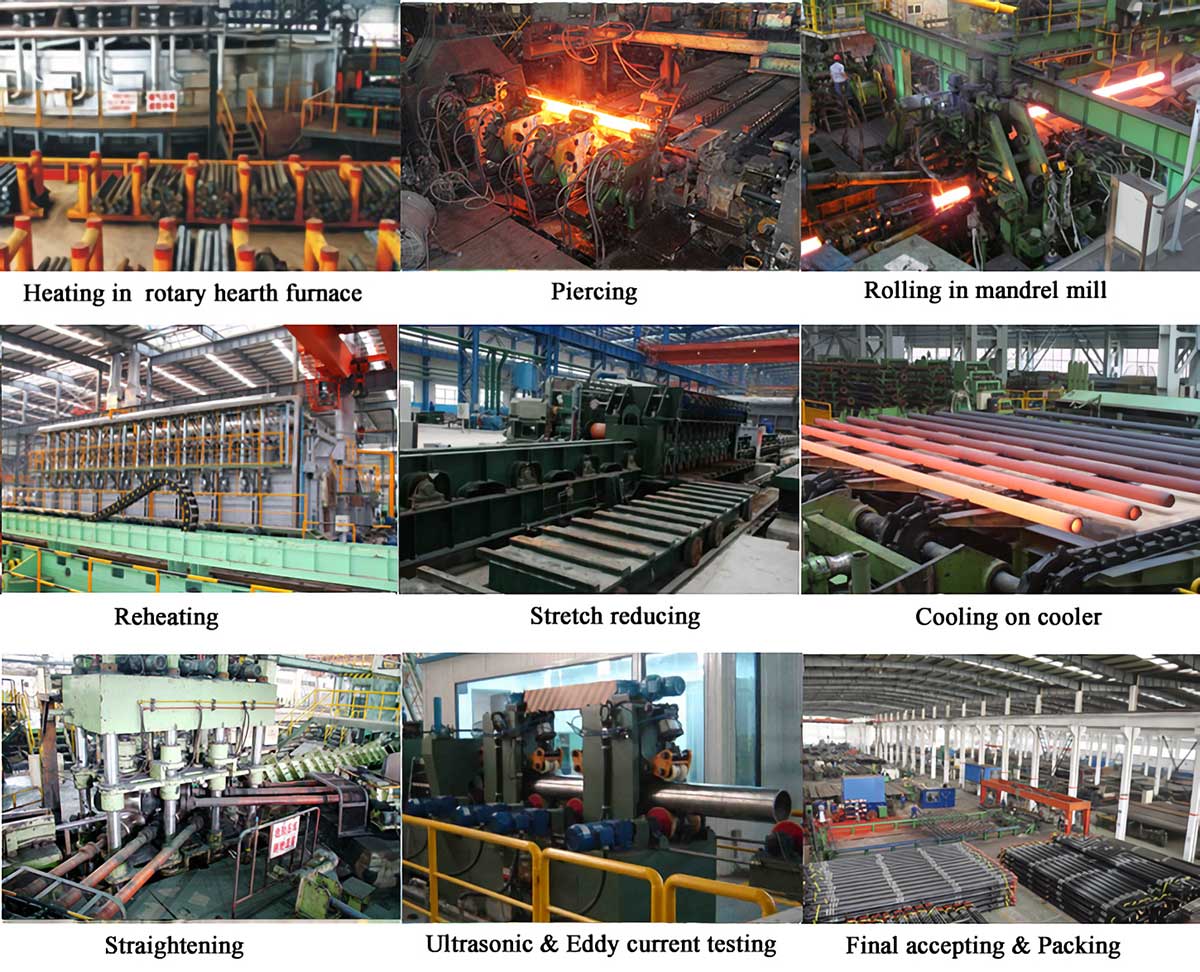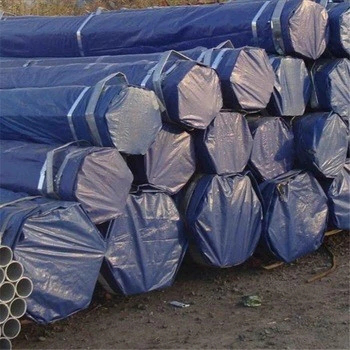Carbon steel pipe mainly refers to the carbon mass fraction is less than 2.11% without containing deliberately added alloying elements of steel, with the level of carbon contained in a steel being one of the most important factors to be influence on its the strength of the steel, the hardness increases, and reduces ductility, toughness and weld ability. Besides, carbon steel tube generally also contain a small amount of silicon, manganese, sulfur, phosphorus in addition to carbon. Compared to other types of steel, CS SMLS pipe is the earliest, low cost, wide range of performance, the largest amount. Suitable for nominal pressure PN ≤ 32.0MPa, temperature -30-425 ℃ water, steam, air, hydrogen, ammonia, nitrogen and petroleum products, and other media. CS seamless pipe is the earliest to use the largest amount of basic material in modern industry. The world's industrial countries, in efforts to increase high strength low alloy steel and alloy steel production, which is also very attention to improving the quality and expanding the range of varieties and use. Proportion of the production in the countries' total output of steel, approximately maintained at about 80%, it is not only widely used in buildings, bridges, railways, vehicles, ships and all kinds of machinery manufacturing industry, but also in the modern petrochemical industry, marine development, has also been heavily used.
Standard: API SPEC 5L,ISO 3183,ASTM A 53M,ASTM A 106M,JIS G 3454,JIS G 3455, JIS G 3456
Dimension:
SMLS: Φ10.3~1016×1.7~52mm
WELD: Φ219~2134×5~52mm
Length: Random Length, Fixed Length, SRL, DRL
Steel Grade:
ASTM A53/ASTM A106: GR A, GR B, GR CASME
ASME A500: GR.A, GR.B, GR.C, GR.D
Test Required:
Chemical Analysis, Mechanical Test, Visusal Inspection , Tension Test, Dimension Check, Bend Test , Flattenting Test, Impact Test, DWT Test, NDT Test, Hydrostatic Test, Hardness Test.
Application of Carbon Steel Tube
- Automobile sectors
- Interior & exterior architectural structures
- Water pipelines
- Gas lines
- Oil & Gas industries
- Pressure service
- Boiler & electric power
- Machinery
- Gas tank
- Chemical engineering
- Offshore and petroleum engineering
Sizes of Carbon Steel Pipe
|
Out Diameter(mm) |
Wall Thickness(mm) |
||||||||||||||||||||||||||
|
6 |
7 |
8 |
9 |
10 |
11 |
12 |
13 |
14 |
15 |
16 |
17 |
18 |
19 |
20 |
21 |
22 |
23 |
24 |
25 |
26 |
27 |
28 |
29 |
30 |
35 |
||
|
73 |
|
|
|
|
|
|
|
|
|
|
|
|
|
|
|
|
|
|
|
|
|
|
|
|
|
|
|
|
76.1 |
|
|
|
|
|
|
|
|
|
|
|
|
|
|
|
|
|
|
|
|
|
|
|
|
|
|
|
|
82.5 |
|
|
|
|
|
|
|
|
|
|
|
|
|
|
|
|
|
|
|
|
|
|
|
|
|
|
|
|
88.9 |
|
|
|
|
|
|
|
|
|
|
|
|
|
|
|
|
|
|
|
|
|
|
|
|
|
|
|
|
101.6 |
|
|
|
|
|
|
|
|
|
|
|
|
|
|
|
|
|
|
|
|
|
|
|
|
|
|
|
|
114.3 |
|
|
|
|
|
|
|
|
|
|
|
|
|
|
|
|
|
|
|
|
|
|
|
|
|
|
|
|
127 |
|
|
|
|
|
|
|
|
|
|
|
|
|
|
|
|
|
|
|
|
|
|
|
|
|
|
|
|
139.7 |
|
|
|
|
|
|
|
|
|
|
|
|
|
|
|
|
|
|
|
|
|
|
|
|
|
|
|
|
152.4 |
|
|
|
|
|
|
|
|
|
|
|
|
|
|
|
|
|
|
|
|
|
|
|
|
|
|
|
|
159 |
|
|
|
|
|
|
|
|
|
|
|
|
|
|
|
|
|
|
|
|
|
|
|
|
|
|
|
|
168.3 |
|
|
|
|
|
|
|
|
|
|
|
|
|
|
|
|
|
|
|
|
|
|
|
|
|
|
|
|
177.8 |
|
|
|
|
|
|
|
|
|
|
|
|
|
|
|
|
|
|
|
|
|
|
|
|
|
|
|
|
193.7 |
|
|
|
|
|
|
|
|
|
|
|
|
|
|
|
|
|
|
|
|
|
|
|
|
|
|
|
|
203 |
|
|
|
|
|
|
|
|
|
|
|
|
|
|
|
|
|
|
|
|
|
|
|
|
|
|
|
|
219.1 |
|
|
|
|
|
|
|
|
|
|
|
|
|
|
|
|
|
|
|
|
|
|
|
|
|
|
|
|
244.5 |
|
|
|
|
|
|
|
|
|
|
|
|
|
|
|
|
|
|
|
|
|
|
|
|
|
|
|
|
273 |
|
|
|
|
|
|
|
|
|
|
|
|
|
|
|
|
|
|
|
|
|
|
|
|
|
|
|
|
298.5 |
|
|
|
|
|
|
|
|
|
|
|
|
|
|
|
|
|
|
|
|
|
|
|
|
|
|
|
|
323.8 |
|
|
|
|
|
|
|
|
|
|
|
|
|
|
|
|
|
|
|
|
|
|
|
|
|
|
|
|
339.7 |
|
|
|
|
|
|
|
|
|
|
|
|
|
|
|
|
|
|
|
|
|
|
|
|
|
|
|
|
355.6 |
|
|
|
|
|
|
|
|
|
|
|
|
|
|
|
|
|
|
|
|
|
|
|
|
|
|
|
|
406.4 |
|
|
|
|
|
|
|
|
|
|
|
|
|
|
|
|
|
|
|
|
|
|
|
|
|
|
|
|
457.2 |
|
|
|
|
|
|
|
|
|
|
|
|
|
|
|
|
|
|
|
|
|
|
|
|
|
|
|
|
473.1 |
|
|
|
|
|
|
|
|
|
|
|
|
|
|
|
|
|
|
|
|
|
|
|
|
|
|
|
|
508 |
|
|
|
|
|
|
|
|
|
|
|
|
|
|
|
|
|
|
|
|
|
|
|
|
|
|
|
|
530 |
|
|
|
|
|
|
|
|
|
|
|
|
|
|
|
|
|
|
|
|
|
|
|
|
|
|
|
|
558.8 |
|
|
|
|
|
|
|
|
|
|
|
|
|
|
|
|
|
|
|
|
|
|
|
|
|
|
|
|
609.6 |
|
|
|
|
|
|
|
|
|
|
|
|
|
|
|
|
|
|
|
|
|
|
|
|
|
|
|
|
630 |
|
|
|
|
|
|
|
|
|
|
|
|
|
|
|
|
|
|
|
|
|
|
|
|
|
|
|
|
Standard |
Type of pipe |
Class |
Grade |
|
API SPEC 5L ISO 3183 |
SMLS |
PLS1 |
L245B, L290 X42, L320 X46 , L360 X52, L390 X56, L415 X60, L450 X65, L485 X70 |
|
PLS2 |
L245N BN, L290N X42N, L320N X46N, L360N X52N, L390N X56N, L415N X60N, L360Q X52Q, L390Q X56Q, L415Q X60Q , L485Q X70Q
|
||
|
PLS2 Sour Environment |
L245NS BNS, L290NS X42NS, L320NS X46NS L360NS X52NS, L390NS X56NS, L415NS X60NS, L360QS X52QS, L390QS X56QS, L415QS X60QS L485QS X70QS
|
||
|
WELD |
PLS1 |
L245B, L290 X42, L320 X46, L360 X52 L390 X56, L415 X60, L450 X65, L485 X70 |
|
|
PLS2 |
L245M BM, L290M X42M, L320M X46M, L360M X52M, L390M X56M, L415M X60M, L450M X65M, L485M X70M, L555M X80M, |
||
Grade:
|
Standard |
Grade |
|
ASTM A 53 M |
A , B |
|
ASTM A 106M |
A, B, C |
|
JIS G 3454 |
STPG 370, STPG 410 |
|
JIS G 3455 |
STPG370, STPG410, STPG480 |
|
JIS G 3456 |
STPG370, STPG410, STPG480 |
Note: Grades other than the a.m. chart can be made available through consultations.
Chemical Composition (%):
|
Standard |
Grade |
C |
Si |
Mn |
P |
S |
Ni |
Cr |
Cu |
Mo |
V |
|
ASTMA 53M |
A |
≤0.25 |
- |
≤0.95 |
≤0.05 |
≤0.045 |
≤0.40 |
≤0.40 |
≤0.40 |
≤0.15 |
≤0.08 |
|
B |
≤0.30 |
- |
≤1.20 |
≤0.05 |
≤0.045 |
≤0.40 |
≤0.40 |
≤0.40 |
≤0.15 |
≤0.08 |
|
|
ASTM A 106M |
A |
≤0.25 |
≥0.10 |
0.27-0.93 |
≤0.035 |
≤0.035 |
≤0.40 |
≤0.40 |
≤0.40 |
≤0.15 |
≤0.08 |
|
B |
≤0.30 |
≥0.10 |
0.29-1.06 |
≤0.035 |
≤0.035 |
≤0.40 |
≤0.40 |
≤0.40 |
≤0.15 |
≤0.08 |
|
|
C |
≤0.35 |
≥0.10 |
0.29-1.06 |
≤0.035 |
≤0.035 |
≤0.40 |
≤0.40 |
≤0.40 |
≤0.15 |
≤0.08 |
|
|
JIS G 3454 |
STPG 370 |
≤0.25 |
≤0.35 |
0.30-0.90 |
≤0.040 |
≤0.040 |
- |
- |
- |
- |
- |
|
STPG 410 |
≤0.30 |
≤0.35 |
0.30-1.00 |
≤0.040 |
≤0.040 |
- |
- |
- |
- |
- |
|
|
JIS G 3455 |
STS 370 |
≤0.25 |
0.10-0.35 |
0.30-1.10 |
≤0.035 |
≤0.035 |
- |
- |
- |
- |
- |
|
STS 410 |
≤0.30 |
0.10-0.35 |
0.30-1.40 |
≤0.035 |
≤0.035 |
- |
- |
- |
- |
- |
|
|
STS 480 |
≤0.33 |
0.10-0.35 |
0.30-1.50 |
≤0.035 |
≤0.035 |
- |
- |
- |
- |
- |
|
|
JIS G 3456 |
STPT 370 |
≤0.25 |
0.10-0.35 |
0.30-0.90 |
≤0.035 |
≤0.035 |
- |
- |
- |
- |
- |
|
STPT 410 |
≤0.30 |
0.10-0.35 |
0.30-1.00 |
≤0.035 |
≤0.035 |
- |
- |
- |
- |
- |
|
|
STPT 480 |
≤0.33 |
0.10-0.35 |
0.30-1.00 |
≤0.035 |
≤0.035 |
- |
- |
- |
- |
- |
Note: Grades other than the a.m. chart can be made available through consultations.
Hot Rolling Seamless Steel Line Pipe Manufacturing / Production Processes
Rolled Round Billets – Examination – Cut Off – Heating – Piercing – Elongation – Slight Tension Reducing – Straightening – Corp End Cutting Off – Visual Inspection – NDT – Hydrostatic Test – Ends Procession – Product Inspection – Painting and Marking – Packing – Warehousing
Cold Drawn (Rolled) Seamless Steel Pipe Manufacturing Process
Mother pipe (Normally for hot rolled pipe) – Inspection – Annealing – Ends Treatment (Hitting and Drilling hole) – Pickling – Grinding – Phosphorization (Annoit) – Cold Drawn (Rolled) – Degreasing and Cleaning – Heat treatment (Solution treatment) – Straightening – Hydrostatic test – Painting and Marking – Warehousing
Surface Treatment of Steel Pipe:
In order to improve the service life of oil pipeline, surface treatment is usually carried out to facilitate the firm combination of steel pipe and anti-corrosive coating.Common processing methods are: cleaning, tool derusting, pickling, shot blasting derusting four categories.
1. Cleaning grease, dust, lubricant, organic matter adhered on the surface of steel pipe, usually using solvent, emulsion to clean the surface. However, the rust, oxide skin and welding slag on the surface of the steel pipe cannot be removed, so other treatment methods are needed. Tool rust removal Steel pipe surface oxide, rust, welding slag, can use steel wire brush to clean and polish the surface treatment.Tool derusting can be divided into manual and power, manual tool derusting can reach SA.
2. Level, power tool derusting can reach Sa3 level. If the surface of steel pipe is attached with a particularly strong oxide skin, it may be impossible to remove the rust with the help of tools, so we need to find other ways.
3. Pickling common pickling methods include chemistry and electrolysis. But only chemical pickling is used for pipeline corrosion protection. Chemical pickling can achieve a certain degree of cleanliness and roughness on the surface of steel pipe, which is convenient for subsequent anchor lines. Usually as a shot (sand) after reprocessing.
4. Shot blasting for rust removal by high power motor drive the high-speed rotating blades, steel grit, steel shot, segment, minerals and other abrasive wire under the action of centrifugal force on steel pipe surface spray and mass ejection, thoroughly remove rust, oxides and dirt on one hand, on the other hand, steel pipe under the action of abrasive violent impact and friction force, to achieve the required uniform roughness. Among the four treatment methods, shot blasting and derusting is an ideal treatment method for pipe derusting. Generally, shot blasting and derusting are mainly used for inner surface treatment of steel pipe, and shot blasting and derusting are mainly used for outer surface treatment of steel pipe.
Spray paint
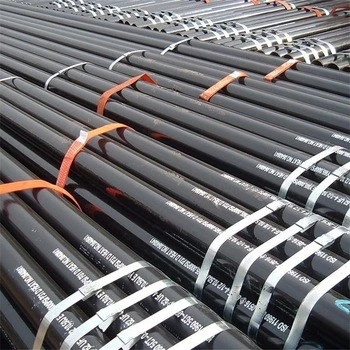
Waterproof packaging


